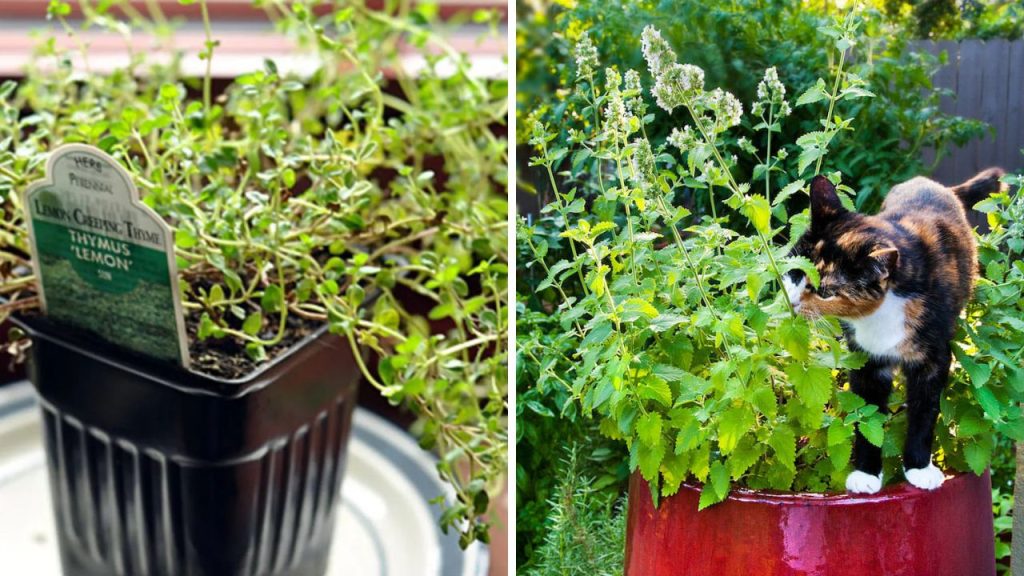Flower gardens can bring so much joy and beauty to any outdoor space. Whether you have a small balcony or a sprawling backyard, there are countless ways to create stunning displays of color and fragrance. Here are 21 flower garden ideas to inspire your next planting project and help you make the most of your green space.
Hanging Flower Baskets
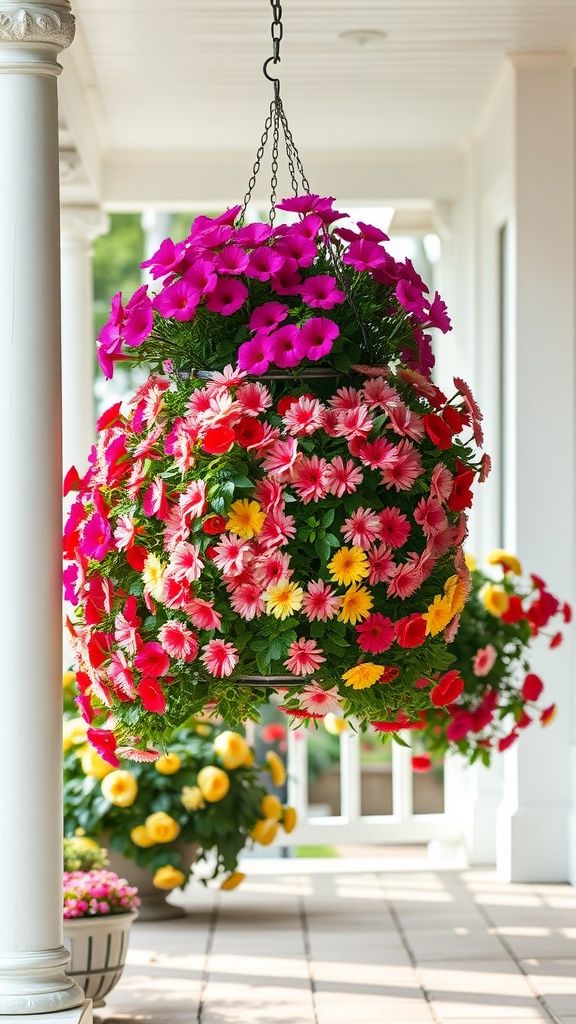
Hanging flower baskets are a fantastic way to add color and charm to any space. They can transform a simple porch or balcony into a vibrant oasis. The image showcases beautiful baskets filled with a mix of pink, yellow, and red flowers, creating a cheerful display.
These baskets are not just pretty; they are also versatile. You can hang them from ceilings, hooks, or even tree branches. The cascading flowers create a stunning effect, drawing the eye upward and making the area feel more open and inviting.
When choosing flowers for your hanging baskets, consider a mix of annuals and perennials. Petunias, begonias, and geraniums are popular choices that thrive in these arrangements. They bloom profusely and offer a variety of colors to brighten your garden.
Maintenance is straightforward. Regular watering and occasional fertilizing will keep your flowers looking their best. With a little care, your hanging baskets can bloom beautifully all season long.
Zen Garden with Flower Accents
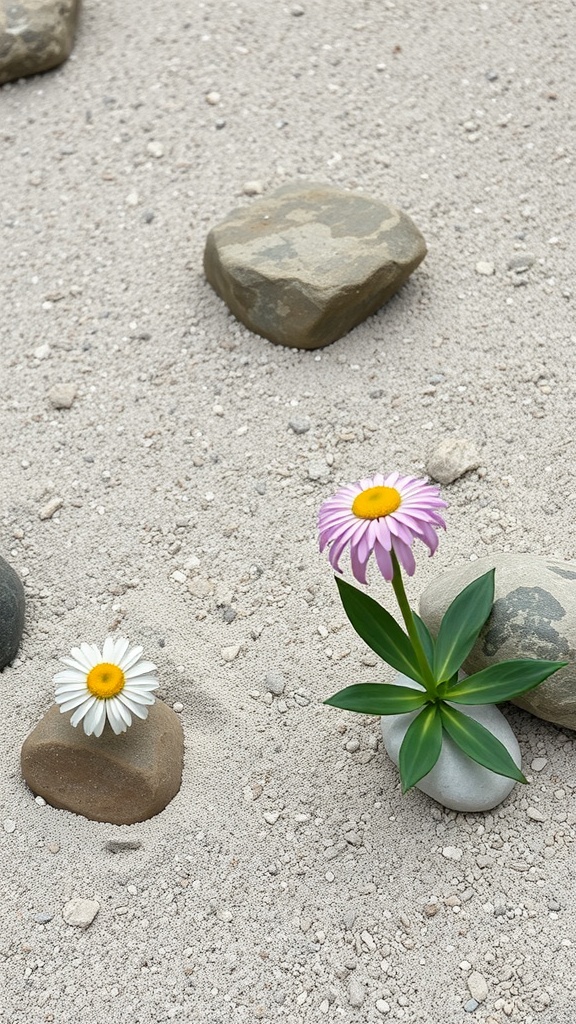
A Zen garden is a peaceful retreat that combines simplicity with beauty. In this design, flowers add a splash of color to the serene landscape. The soft sand and carefully placed stones create a calming atmosphere, while the flowers bring life and vibrancy.
The two flowers in the image stand out against the sandy backdrop. One is a cheerful white daisy, and the other is a lovely pink bloom. Their placement among the stones invites a sense of harmony and balance. This setup encourages mindfulness and reflection, making it a perfect spot for relaxation.
To create your own Zen garden with flower accents, start with a small space. Use fine sand or gravel as the base, and arrange stones in a way that feels natural. Choose a few flowers that resonate with you, and place them strategically among the stones. This simple design can transform any corner of your yard into a tranquil escape.
Seasonal Flower Bed Rotation
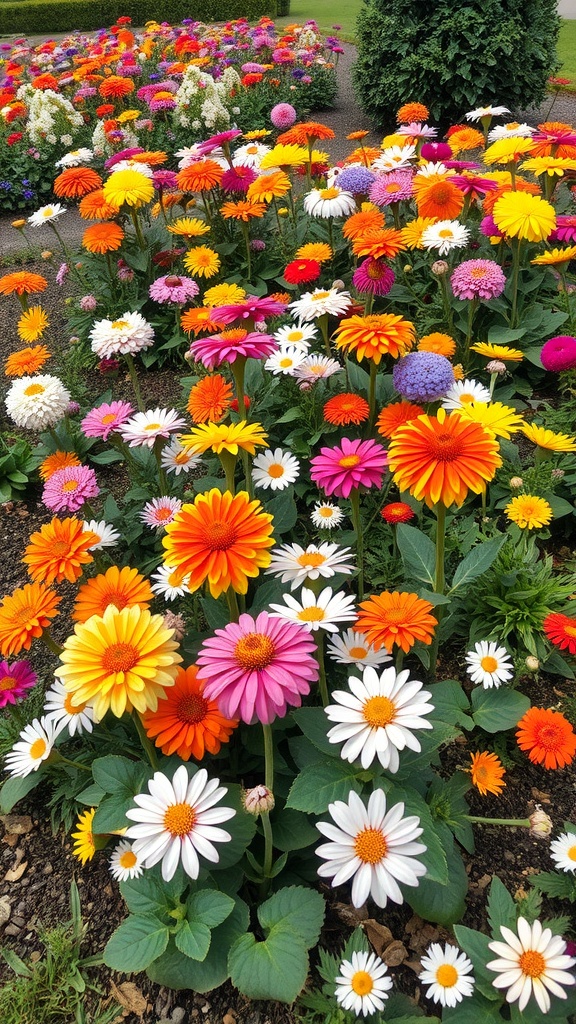
Flower beds can bring so much joy and color to your garden. Rotating your flower beds seasonally is a fun way to keep your garden fresh and vibrant. The image shows a lively mix of flowers in bright colors, showcasing how beautiful a well-planned flower bed can be.
When you rotate your flowers, you can choose different blooms for each season. This not only keeps things interesting but also helps with soil health. For example, planting sunflowers in the summer and chrysanthemums in the fall can create a stunning visual transition.
Consider the height and color of the flowers when planning your rotation. Tall flowers like sunflowers can stand proudly at the back, while shorter ones like daisies can fill in the front. This layering creates depth and makes your garden visually appealing.
Don’t forget to think about the blooming times. Some flowers bloom early in the season, while others may not show their colors until later. Mixing these can ensure your garden looks beautiful from spring through fall.
Vertical Gardens for Small Spaces
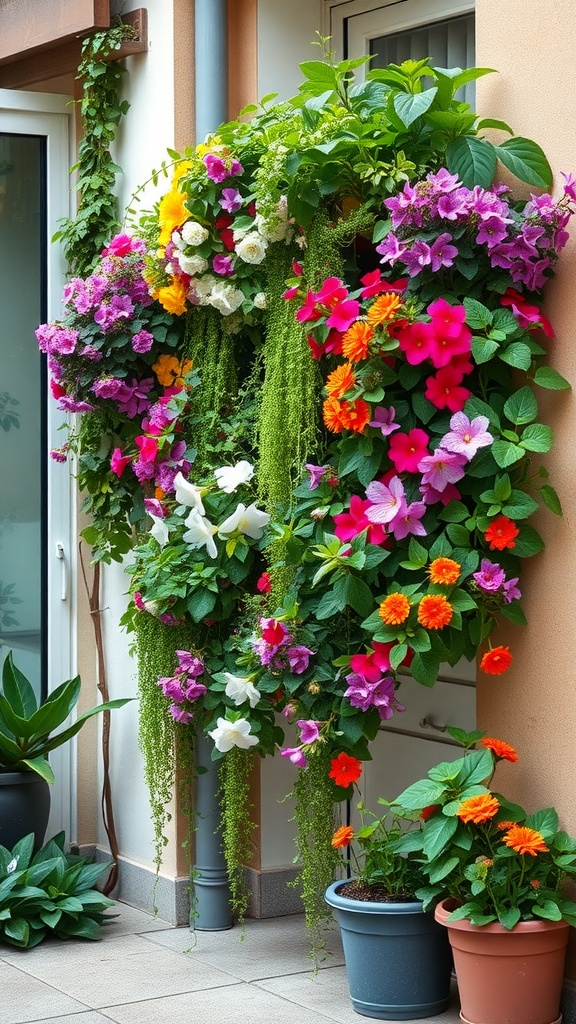
Vertical gardens are a fantastic way to bring life to small spaces. They allow you to maximize your area while adding a burst of color and texture. The image shows a vibrant vertical garden filled with a variety of flowers, creating a stunning visual impact.
This setup features a mix of bright blooms like pink, orange, and white flowers cascading down. The lush greenery complements the colorful petals, making it a delightful sight. Vertical gardens can be hung on walls or fences, making them perfect for patios, balconies, or even indoor spaces.
Using vertical gardening techniques, you can create a mini oasis without needing a large yard. Consider using wall-mounted planters or trellises to display your favorite flowers. This not only saves space but also adds an artistic touch to your home.
Whether you choose flowering plants or trailing vines, a vertical garden can transform any small area into a lively retreat. So, grab some pots and get started on your vertical garden today!
Butterfly Garden Design
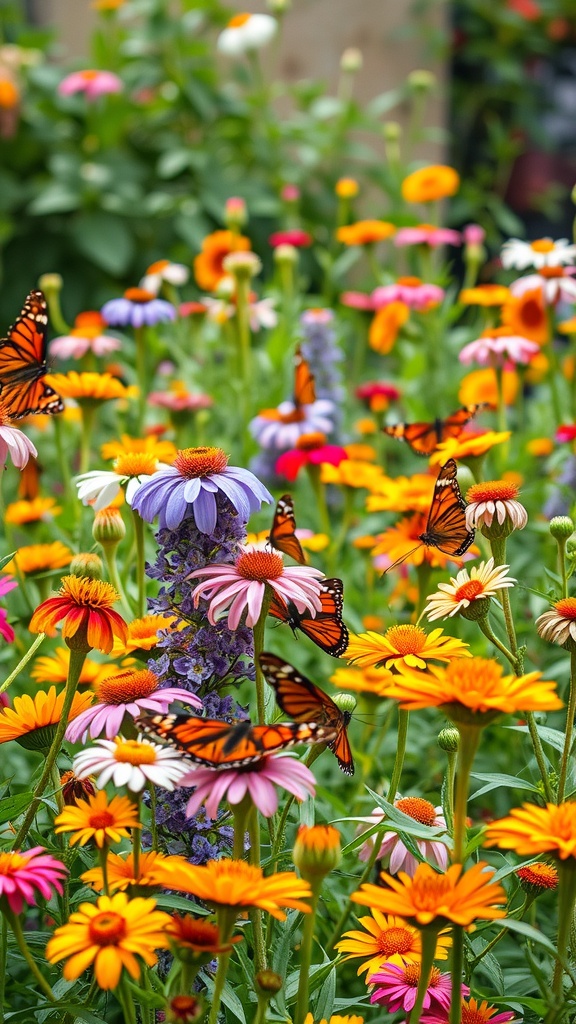
Creating a butterfly garden is a delightful way to attract these beautiful creatures to your outdoor space. The image shows a vibrant mix of flowers, including daisies and coneflowers, all in full bloom. Butterflies flutter around, adding life and color to the scene.
To start your butterfly garden, choose flowers that bloom at different times. This ensures that there’s always something for butterflies to enjoy. Bright colors like orange, pink, and purple are particularly appealing to them. The flowers in the image are perfect examples of what to plant.
Consider adding native plants, as they are often the best for local butterfly species. Plants like milkweed are essential for monarch butterflies. A mix of nectar-rich flowers will keep butterflies coming back throughout the season.
Don’t forget to include some flat stones for sunbathing and shallow water sources for drinking. These small additions can make your garden even more inviting. With a little planning, you can create a lovely butterfly haven right in your backyard!
Wildflower Meadow
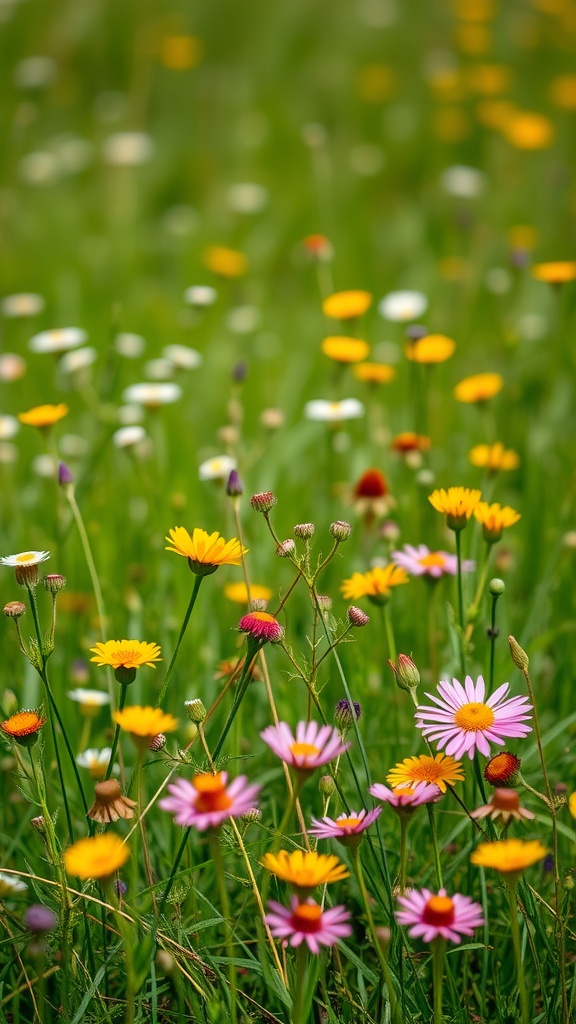
Creating a wildflower meadow is a fantastic way to bring a splash of color and life to your garden. This image showcases a delightful mix of wildflowers, featuring vibrant yellows, pinks, and whites. The variety of blooms creates a natural, carefree look that is both inviting and beautiful.
Wildflower meadows are not just pretty; they also support local wildlife. Bees, butterflies, and other pollinators thrive in these environments. By planting a mix of native flowers, you can create a habitat that encourages biodiversity.
To start your own wildflower meadow, choose a sunny spot in your yard. Prepare the soil by removing weeds and debris. Then, scatter a mix of wildflower seeds. Water them lightly and watch as they grow into a stunning display of nature’s beauty.
These meadows require minimal maintenance. Once established, they can thrive with little care, making them a perfect choice for busy gardeners. Enjoy the changing colors throughout the seasons, and take time to relax in your own little slice of nature.
Container Flower Gardens
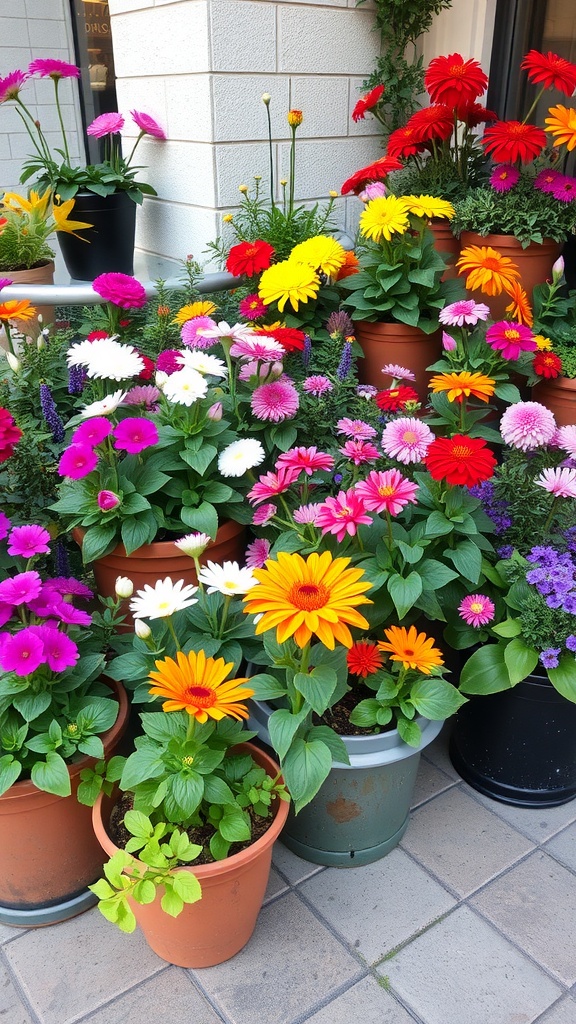
Container flower gardens are a fantastic way to bring color and life to any space. They are perfect for small areas, balconies, or patios. The image showcases a vibrant display of flowers in various pots, creating a cheerful atmosphere.
Using containers allows for flexibility in design. You can mix and match different flowers to create a unique look. In the image, you can see bright gerbera daisies, cheerful petunias, and lovely daisies all thriving together. This variety adds depth and interest to the garden.
Another great aspect of container gardens is that they can be easily moved. If you want to change the layout or bring them indoors during bad weather, it’s a simple task. Plus, they can be arranged to suit your style, whether you prefer a neat and tidy look or a more relaxed, bohemian vibe.
Don’t forget about the importance of choosing the right pots. The containers should have good drainage to keep the roots healthy. You can also play with different materials like terracotta, ceramic, or even recycled items for a fun twist.
Cottage Garden Charm
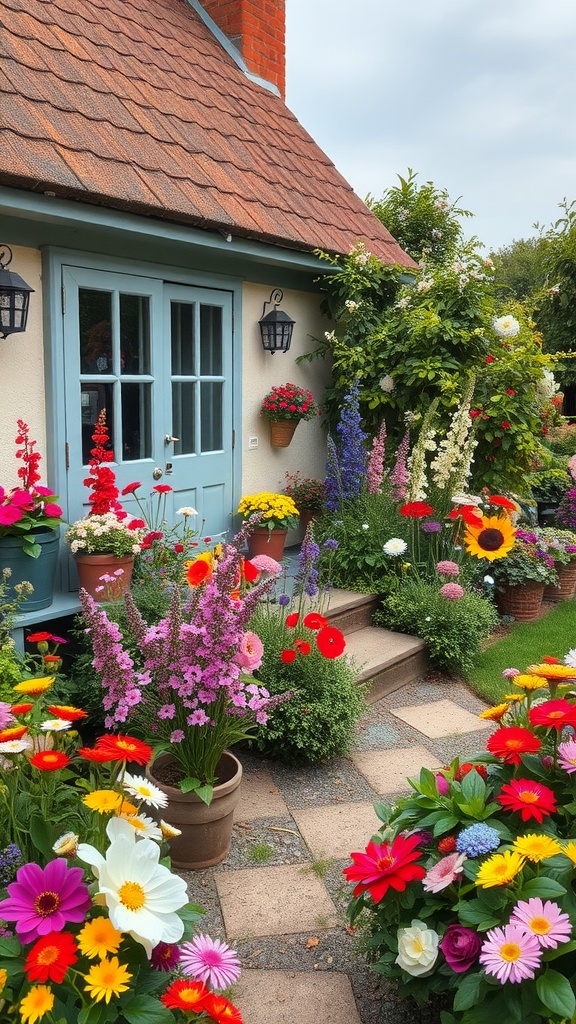
Cottage gardens are a delightful blend of colors and textures. This image captures the essence of such a garden, showcasing a charming home surrounded by vibrant flowers. The mix of blooms creates a welcoming atmosphere that feels both cozy and inviting.
Notice the variety of flowers, from tall snapdragons to cheerful daisies. Each plant adds its own character, making the garden feel alive. The carefully arranged pots and the stone pathway lead the eye toward the door, inviting you to step inside and enjoy the beauty within.
This style is all about embracing nature’s chaos. You don’t need to stick to strict patterns or colors. Instead, let your creativity flow. Mix different heights and colors for a lively look. A cottage garden is perfect for those who love a relaxed, informal vibe.
Consider adding some climbing plants to your trellis or wall. They can enhance the charm and provide a lush backdrop. With a little planning, your garden can become a beautiful retreat, full of life and color.
Color-Themed Flower Borders
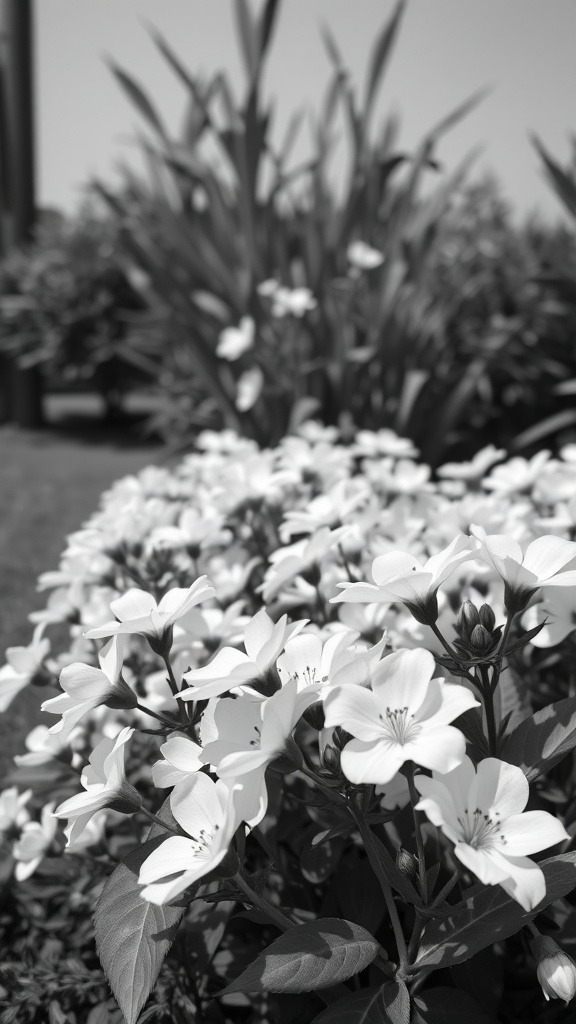
Creating a stunning flower border can transform any garden space. The image shows a beautiful arrangement of white flowers, which can serve as a perfect example of how color themes can enhance your garden’s appeal. White flowers bring a sense of calm and elegance, making them a great choice for borders.
When planning your flower borders, think about how different colors can complement each other. For instance, pairing white flowers with vibrant colors like reds or yellows can create a striking contrast. This not only highlights the beauty of each flower but also adds depth to your garden.
Consider the height and spread of the flowers as well. Taller plants can serve as a backdrop, while shorter varieties can fill in the front. This layering effect adds dimension and makes your flower borders more visually interesting.
Don’t forget about the seasons! Choose flowers that bloom at different times to ensure your borders look great year-round. With a little planning and creativity, you can create stunning color-themed flower borders that will make your garden a delightful place to relax and enjoy.
Flower Pathways
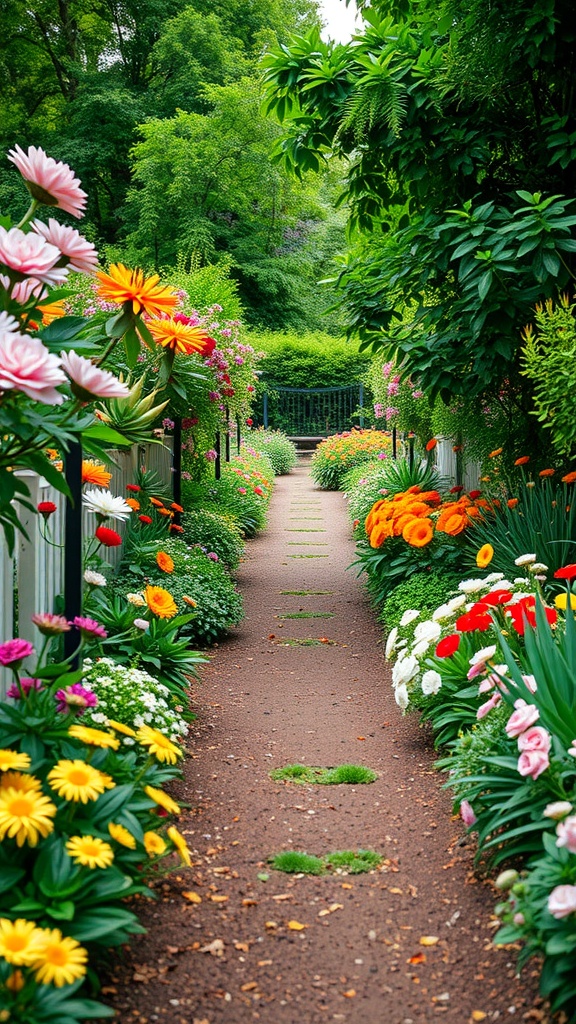
Flower pathways can transform any garden into a delightful experience. Imagine walking down a path lined with colorful blooms, each step revealing new shades and scents. This image captures a perfect example of how flowers can create a welcoming and vibrant walkway.
The pathway is flanked by an array of flowers, showcasing bright yellows, pinks, and oranges. These colors not only brighten the space but also invite visitors to explore further. The greenery surrounding the flowers adds a lush feel, making the pathway feel like a secret garden.
Using flowers to line a pathway can also serve practical purposes. It can guide guests through your garden while adding beauty. Consider planting seasonal flowers for variety throughout the year. This way, your pathway remains fresh and engaging, no matter the season.
Flower Garden for Pollinators
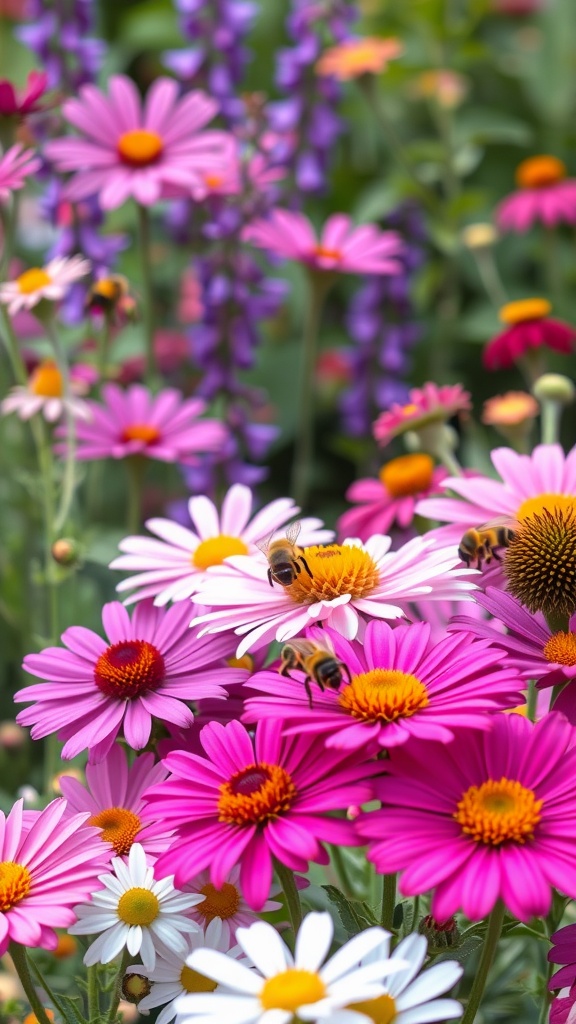
Creating a flower garden that attracts pollinators is a rewarding way to support nature. The image shows a vibrant mix of flowers, including pink and white daisies, all buzzing with activity from bees. These colorful blooms not only brighten up the garden but also provide essential food for these important creatures.
To design your own pollinator-friendly garden, consider planting a variety of flowers that bloom at different times. This ensures that there’s always something in bloom for the bees and butterflies. Flowers like daisies, lavender, and coneflowers are excellent choices. They are not only beautiful but also rich in nectar.
Another tip is to avoid using pesticides. These chemicals can harm pollinators. Instead, opt for natural pest control methods. Adding native plants can also help, as they are well-suited to local pollinators and require less maintenance.
Incorporating a water source, like a small birdbath, can also attract more wildlife. Remember, a thriving flower garden for pollinators is a step towards a healthier ecosystem.
Flowering Shrubs and Perennials
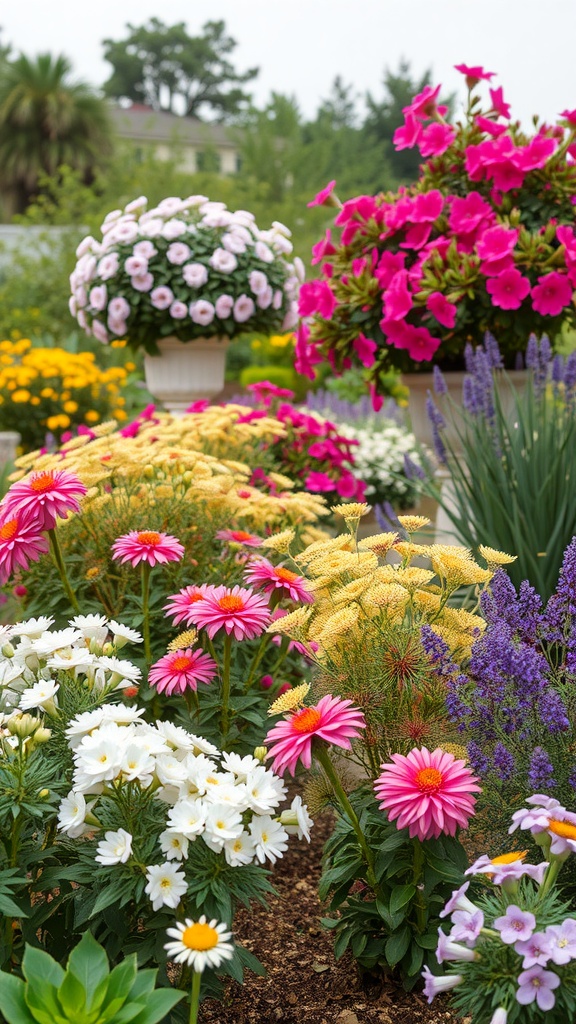
Flowering shrubs and perennials can truly elevate your garden. The image showcases a vibrant mix of colors and textures, making it a feast for the eyes. Bright pinks, whites, and yellows create a lively atmosphere, inviting anyone to stop and admire.
Incorporating flowering shrubs adds structure to your garden. They can serve as focal points or borders, giving depth to your landscape. Perennials, on the other hand, are perfect for creating a lush, layered look. They return year after year, making them a smart choice for low-maintenance beauty.
Consider mixing different heights and colors. Tall lavender and cheerful daisies can complement shorter blooms beautifully. This variety not only attracts pollinators but also keeps your garden looking fresh throughout the seasons.
Don’t forget about the importance of seasonal interest. Choose perennials that bloom at different times to ensure your garden is always in bloom. This way, you can enjoy a colorful display from spring through fall.
Edible Flower Garden
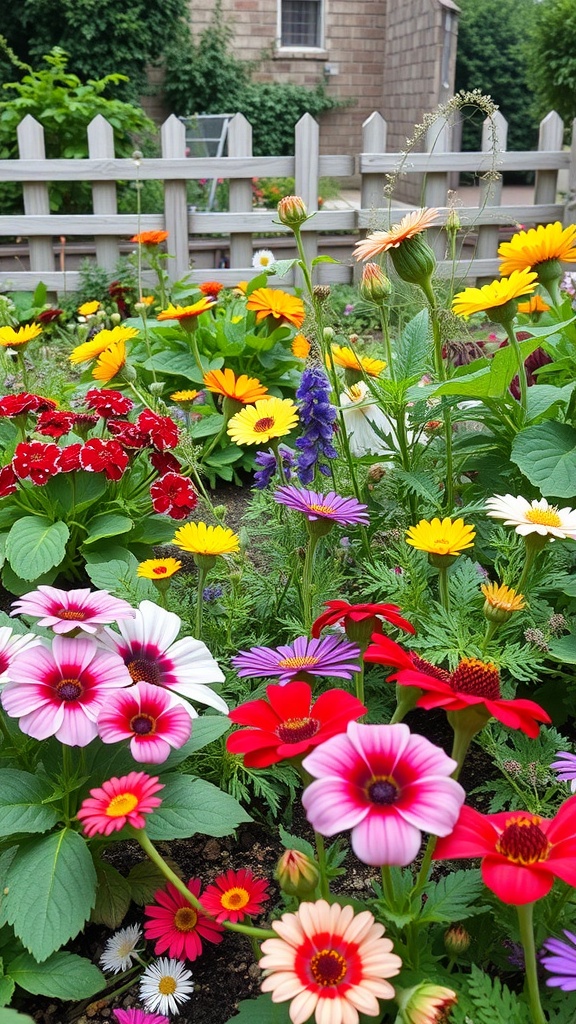
Creating an edible flower garden is a fun way to add color and flavor to your meals. The image showcases a vibrant mix of flowers, each with its own unique taste and culinary uses. You can see bright yellows, reds, and pinks, making it not just a feast for the eyes but also for the palate.
Flowers like nasturtiums, pansies, and marigolds are popular choices. They can be used in salads, as garnishes, or even in desserts. The petals are often edible and can add a delightful twist to your dishes.
To start your own edible flower garden, choose a sunny spot in your yard. Prepare the soil and plant a variety of flowers. Water them regularly and watch them bloom. Soon, you’ll have a beautiful garden that’s also a source of fresh ingredients for your cooking.
Remember to research which flowers are safe to eat and how to prepare them. Some flowers may require specific handling or cooking methods. Enjoy the process of growing and using your edible flowers!
Scented Flower Gardens
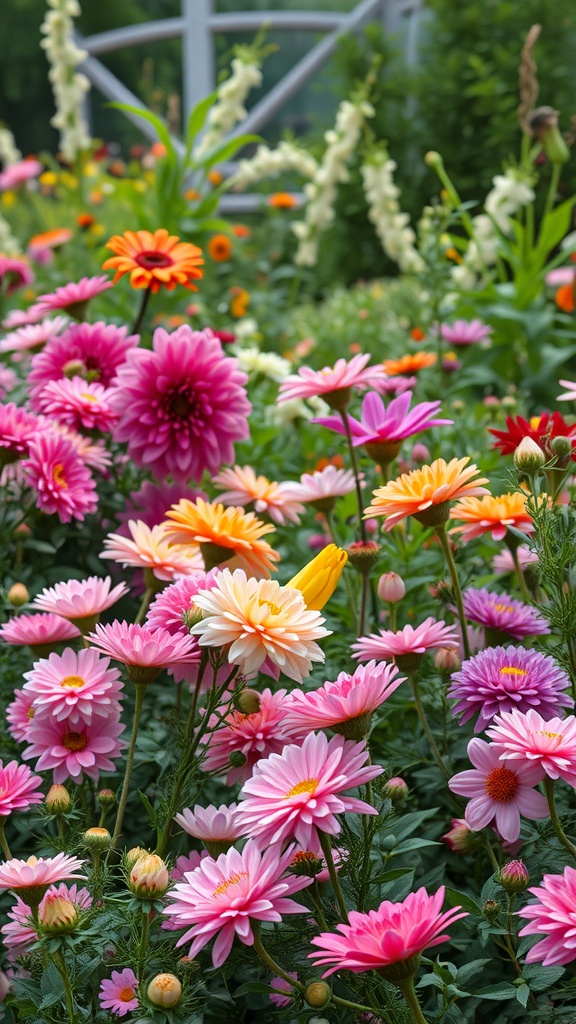
Scented flower gardens can transform any outdoor space into a fragrant paradise. Imagine stepping into a garden filled with blooms that not only look beautiful but also fill the air with delightful scents. The image showcases a vibrant array of flowers, including pink and orange daisies, which are known for their sweet aroma.
Creating a scented flower garden is simple. Start by choosing flowers that are known for their fragrance. Some popular options include lavender, roses, and jasmine. These flowers not only add color but also attract pollinators like bees and butterflies.
When planning your garden, consider the layout. Grouping fragrant flowers together can create a stronger scent. You can also plant them near pathways or seating areas to enjoy their aroma while relaxing outdoors. Don’t forget to include some herbs like mint or basil, which can also add a lovely scent to your garden.
Maintaining your scented flower garden is key. Regular watering and deadheading spent blooms will keep your flowers healthy and fragrant. With a little care, your garden will be a delightful escape for all your senses.
Shade Flower Gardens
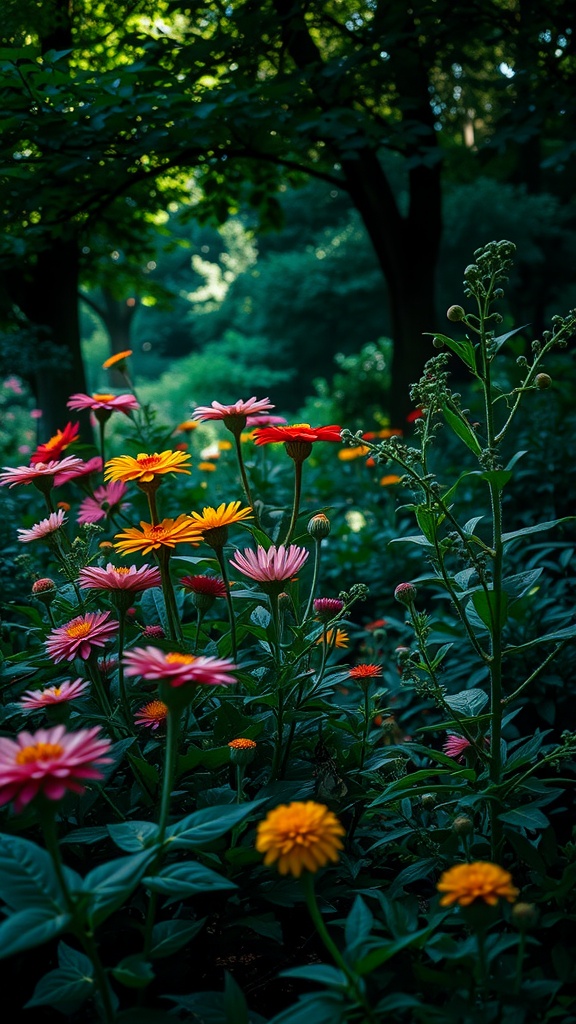
Shade flower gardens can be a delightful escape, filled with vibrant colors and textures. The image shows a beautiful arrangement of flowers thriving in a shaded area, showcasing how even low-light conditions can support a lively garden.
In this garden, you can see a mix of pink, yellow, and orange flowers, each adding its charm to the scene. The lush greenery surrounding the blooms creates a cozy atmosphere, making it a perfect spot to relax.
Choosing the right flowers for shade is key. Some great options include astilbe, hostas, and ferns. These plants not only thrive in low light but also bring a variety of shapes and colors to your garden.
Creating a shade garden can be simple and rewarding. Start by assessing the light conditions in your space, then select flowers that will flourish in those conditions. With a little planning, you can transform a shaded area into a stunning floral retreat.
